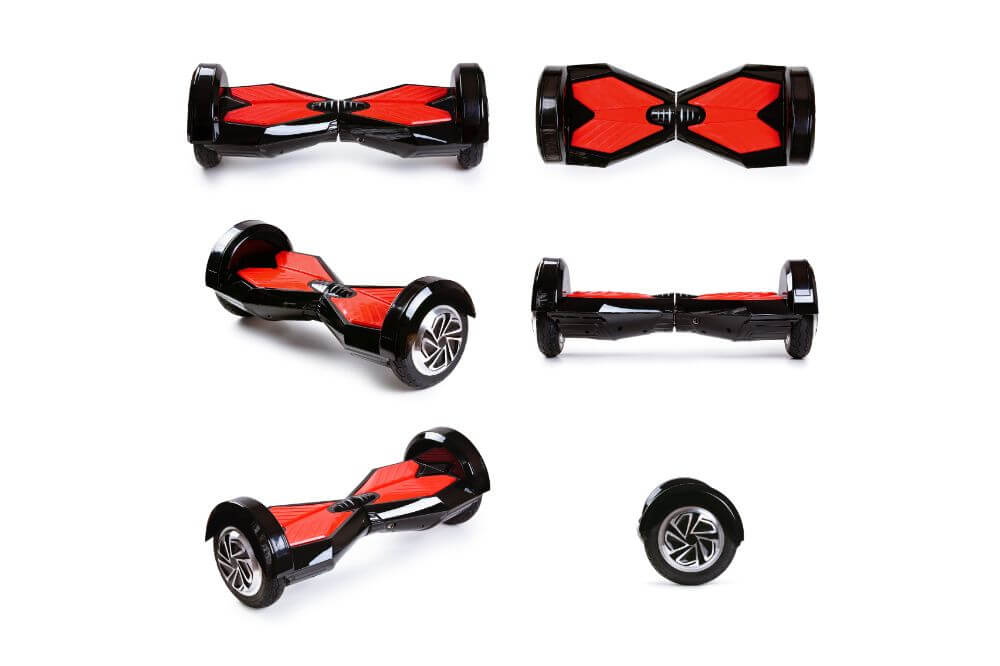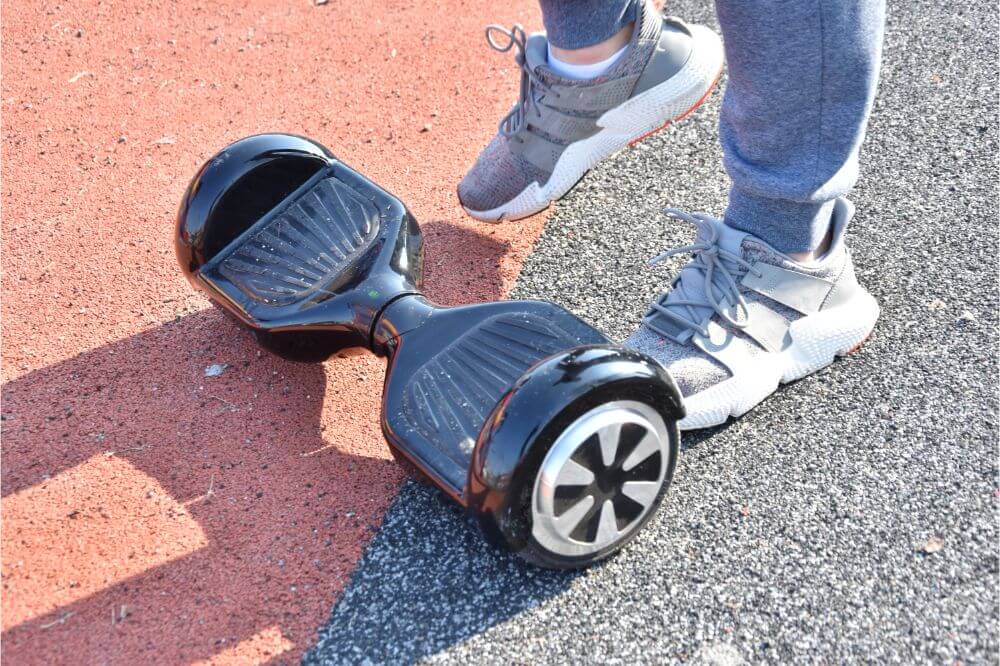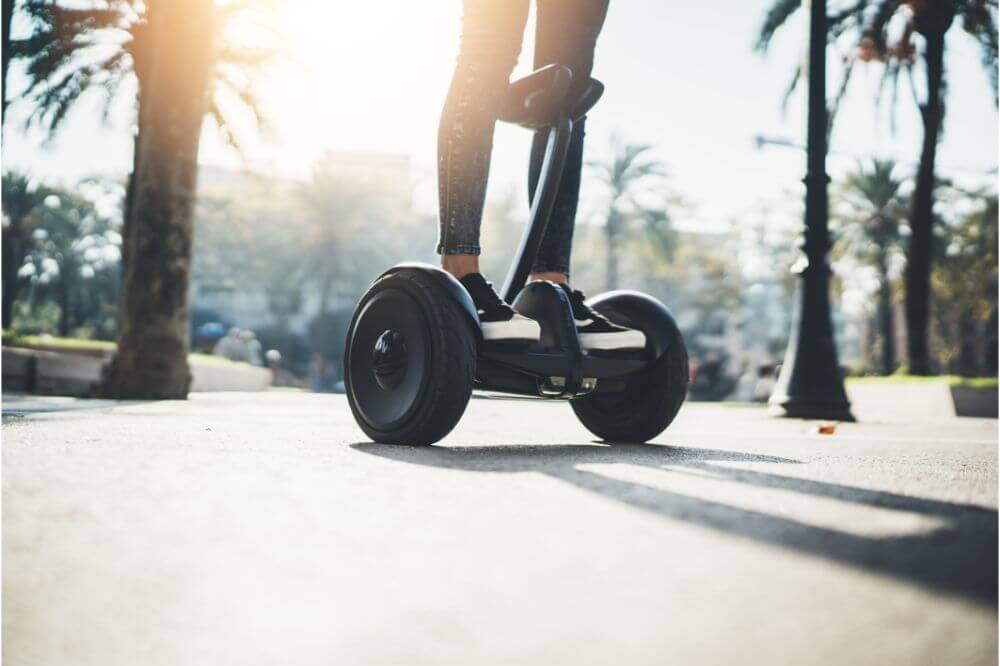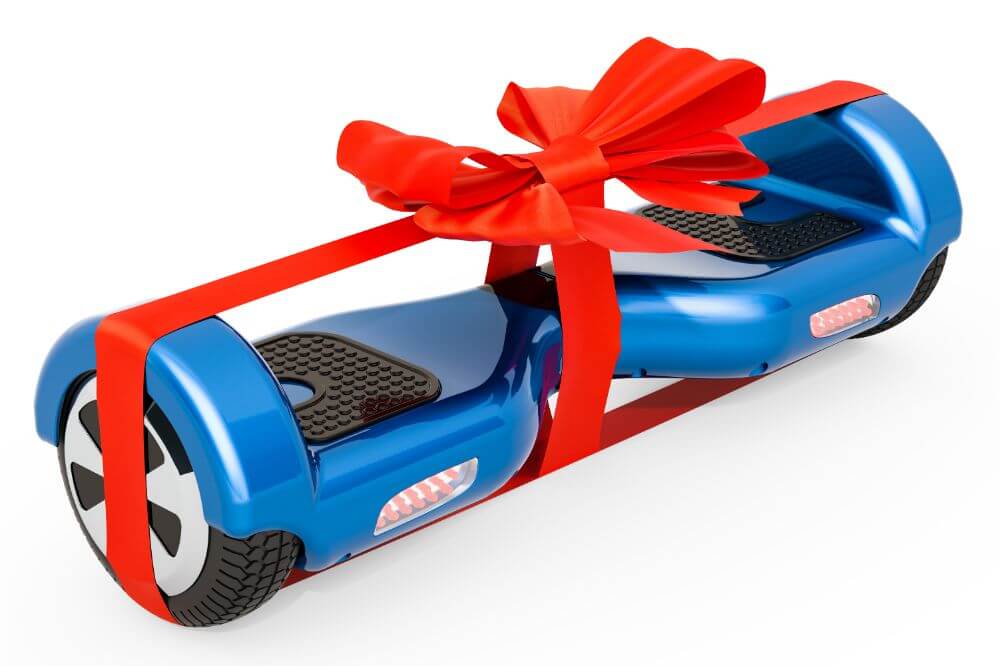- A quick history of hoverboards
- Do hoverboards really hover?
- Is a hoverboard a kind of electric skateboard? Or Segway?
- What are the main parts of a hoverboard?
- How do hoverboards work?
- How do you ride a hoverboard?
- Are hoverboards legal?
- Should I ride a hoverboard?
- How Much Do They Cost?
- Are They for Boys or Girls?
- Why You Need a Hoverboard
- Conclusion
You may not have had the pleasure of riding on a hoverboard, but there’s a good chance you have seen them in movies or at least heard about them.
So what is a hoverboard? To give you a simple definition, a hoverboard is a personal transportation device consisting of two motorized wheels connected by a board on which the rider stands. To see the hottest ones on the market today, head over to my article on the best hoverboards currently available, or browse these awesome hoverboards for sale.
But here’s the funny thing: these devices don’t actually hover! A more correct term for hoverboards is self balancing scooter. I’ll get more into that below as I answer some of the most common questions related to what exactly a hoverboard is.
A quick history of hoverboards

According to this page on Wikipedia, hoverboards were first conceptualized and named by M. K. Joseph in his 1967 science fiction novel The Hole in the Zero.
But the masses were not aware of the idea of hoverboards until Back to the Future II popularized them in 1989. In it, the movie’s protagonist Marty McFly travels to the future and sees teenagers riding on a skateboard-style levitating boards. Hilariously, the film was set in “the future” of 2015. Now, that year is long behind us. Scientists are developing true levitating boards, but these have yet to be perfected and mass marketed (they’re working on it!)

What we call hoverboards today were invented in 2013 and produced in high volume starting in 2014. However, hoverboards had a bumpy introduction to the market, as the earlier models had a tendency to catch fire or explode, even causing a few deaths. Fortunately, most hoverboards made and sold today are safe.
Since then, this stylish mode of personal transportation has appeared in many movies and has been further popularized by celebrities like Wiz Khalifa, Justin Bieber, Kendall Jenner, Skrillex and Nick Jonas.
What is the future of hoverboards? Will their popularity continue to increase? What’s most likely is that they will only continue to get better as technology keeps advancing, with more awesome features, better battery mileage, and so on.
They will normally have a max speed of 6 – 9 miles per hour and many can move over rough terrain and road surfaces. You can get a Bluetooth hoverboard, which has speakers built-in. Many parents have safety concerns but all hoverboards have to meet strict safety requirements to be sold in the US.
Do hoverboards really hover?
Sorry to break it to you, but no, the things that we call hoverboards today don’t actually hover. They glide around on motorized wheels. But seen from certain angles, or when you’re riding one, they certainly do seem to hover!
This is why “self balancing scooter” is a more correct term for the hoverboard, and you will still see it used in many product names and descriptions. Still, hoverboard has come to be the most commonly used term for these devices.
Hoverboards work best on smooth cement, but more expensive “off road hover boards” can handle surfaces like grass, sand, dirt, or wet surfaces.
Is a hoverboard a kind of electric skateboard? Or Segway?

A hoverboard is not an electric skateboard, even though both are motorized personal transportation devices. Electric skateboards look more like traditional skateboards, except they have a small motor on them which is controlled by a remote held by the rider. Hoverboards actually have more complex systems, different features, and are heavier, just to name a few differences. You can read about this in more detail in my guide to the differences between skateboards and hoverboards.
A hoverboard is also not a Segway. These are much larger (and heavier devices) used for riding around. They come with a handlebar for steering, which a hoverboard lacks. What’s more, Segway is a brand name, while hoverboard is a kind of product that is made by many different brands.
What are the main parts of a hoverboard?
Let’s do a quick breakdown of a hoverboard to find out what these self-balancing scooters are made up of. The main parts of a hoverboard include:
- Two wheels, which come in 6.5, 8, or 10-inch size
- A motors that provides torque, or spinning power
- Gyroscopes, which help to achieve balance
- A circuit board or motherboard with microprocessors that control power output to the wheels
- Batteries to fuel the device
- The board surface on which the rider sands
- Extra features such as speakers, LED lights, LCD screen, and more
How do hoverboards work?
For a self-balancing scooter to perform well, it is important that it stays upright. The microprocessors in the device are designed to control the direction towards which the rider is leaning. The gyroscope that is linked to the microprocessors assist in collecting more information regarding the tilt of the hoverboard.
To maintain the balance of the rider, the motors inside the board change the power output. It is interesting to note that each hoverboard is unique in its pwn way and each one utilizes a different set of batteries, motors, and microprocessors. You can read a more detailed description of this process in my article on how hoverboars work.
How do you ride a hoverboard?
To begin, you need to step on the board with one foot first (usually your right foot if you’re right handed, as that feels natural to most) and place it as close as possible to the edge (wheel). Next, you step on with the other foot, at the opposite end of the board. Now you’ll be able to stand, and boards with added self-balancing technology make balancing even easier.
As you ride, you can move the hoverboard in any direction you want by putting your body weight in that particular direction. To stop, you lean gently backwards (but lean too far back and you’ll start going backwards!) For a more detailed explanation, see my guide to how to ride a hoverboard.
Are hoverboards legal?
Although hoverboards are quite popular these days, they are not legal to ride in many cities. In the New York City, for example, hoverboards are illegal, even though some other forms of motorized personal transportation like electric skateboards were made legal in 2020.
In the UK, hoverboards are only legal on private property, while in Canada, the rules vary by province and even city. Thus you’ll definitely need to look up what the laws are in your country or city for riding hoverboards.
The main issue in many places is that hoverboards are new and there isn’t agreement about to classify them. Because they have motors, they are often lumped in with vehicles, but they don’t meet the same standards that regular vehicles do for driving on the road. Despite laws against them, though, enforcement is sporadic, and you may actually see quite a few people still riding them.
Some airlines such as the American, United, and Delta Airlines have banned hoverboards on flights, including in your check-in luggage. The reason behind this is that the high-watt batteries used in these hoverboards may trigger a fire in the luggage section of the airplane.
Should I ride a hoverboard?
I can’t answer that question. But what I can do is provide you with loads of information so that you can decide if a hoverboard is for you, which one is the best for your needs, how to learn to ride it, and how to use your hoverboard safely. Feel free to explore the advice section of Portable Wheelers to get all the answers you need, and the reviews section for detailed reviews of specific boards.
How Much Do They Cost?
Like all new electronic devices, hoverboards started out quite expensive, and now their cost keeps going down every years. Today, you can even get $100 hoverboards, but they are going to lack features and quality. With less than $200, you can get some pretty great beginner’s boards like these.
If you’re willing to spend $250 to $500, then you can expect a more robust, powerful board with a stronger motor, faster speed. These are also better equipped to handle larger riders, and often come with offroading capability. At the top end, some hoverboards can reach $1000 or more.
Are They for Boys or Girls?
One great thing about hoverboards is that they are totally unisex. No matter what your gender is or how you identify, just choose a color you like! If you do want an especially girly one, though, have a look at my guide to the top hoverboards for girls.
Why You Need a Hoverboard
Sure, hoverboards make for a quick, efficient way for you to get around, but there’s more to these incredible devices than just how far they can take you. It might surprise you to learn that hoverboards offer a wide range of benefits to your health and posture – we’re going to take a look at those benefits now.
They Burn Calories!
While watching someone ride around on a hoverboard might not seem the same as watching someone work out at the gym, riding a hoverboard is a kind of exercise. A quick 30-minute ride can burn up to 300 calories, though it’s important to remember that different boards will produce different results.
S-shaped hoverboards help keep the rider balanced, which allows them to burn more calories. With that being said, even how a basic hoverboard engages your muscles serves as a workout.
Enhanced Reflexes
Even when you ride around on a cheap hoverboard, you increase your ability to balance while at the same time improving your reflexes. A hoverboard is a balanced device that forces you to improve your ability to balance while also helping you improve your reflexes.
Because of how these practical devices work, you constantly have to shift forward and backward to maintain balance. If you lean too far in either direction, you run the risk of falling! But, after a good while of practice, riding becomes natural as your reflexes grow stronger.
Improved Focus
Hoverboards might not look like the quickest devices in the world, but they’re all equipped with a powerful motor, and some can travel as fast as 10 miles an hour. Moving at this speed requires a lot of concentration to help you stay upright and avoid falling over.
Balance practice-based activity helps you enhance concentration skills as you focus on the world whizzing by and maintaining your balance on these practical devices.
Improved Posture
While riding a bicycle can undoubtedly help you stay healthy and fit, if you’re sitting in a hunched position while riding your bike, your posture is going to suffer as you put stress on your lower back. Being hunched over isn’t an option when riding a hoverboard – hoverboards help you keep your back straight by forcing you to engage your core, which helps improve your posture overall.
Your body is provided with a complete head-to-toe workout while not making you feel too tired after riding sessions. Hoverboards require a lot of abdominal strength and muscle control from the rider, so some people might not perform too well on them. However, if you’re healthy and passionate about staying that way, then hoverboards can make for a fantastic option for you to improve your muscle strength, focus, concentration, posture, and more.
And, if you have kids, you can make a fun activity out of hoverboard riding by taking rides together as a family!
Conclusion
There’s no doubt that riding hoverboards is a lot of fun! If you are looking to buy one then we would suggest that you do a thorough market study to find the one that’s best in quality. Like any other electronic device, you need to learn to operate them well and use them responsibly. Learn about the laws of your city, state/province, or country to ensure that there are no rules against riding hoverboards on the street.
Hopefully this article has provided you with even more information than you expected to find about what hoverboards are all about!

